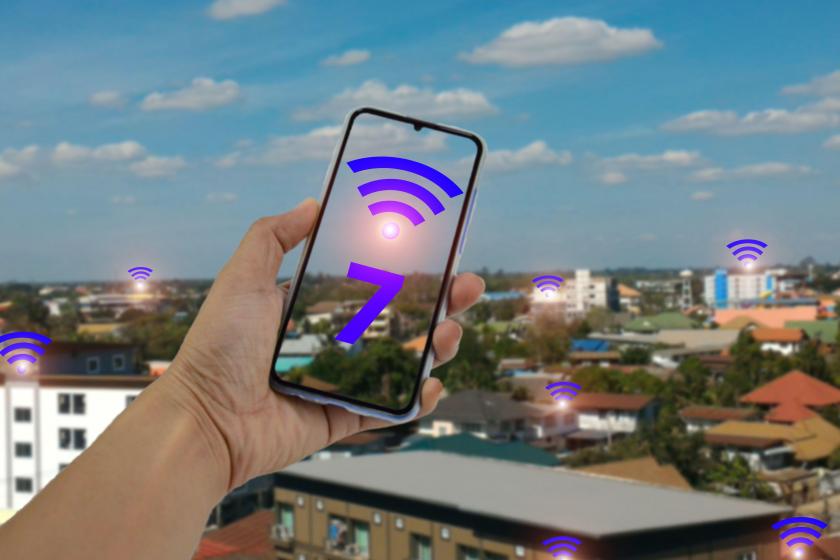Wi-Fi 7 Gets Boost from Qualcomm AI-Optimized ChipsetWi-Fi 7 Gets Boost from Qualcomm AI-Optimized Chipset
The vendor claims the new set will enhance features and functionality when used in products compliant with the latest Wi-Fi Version.
March 1, 2024

In a move likely to move the needle on the emergence of Wi-Fi 7 product use, Qualcomm launched an AI-optimized chipset for the latest version of the wireless specification this week.
Announced at the Mobile World Congress (MWC) 2024 global mobile event in Barcelona this week, the Fast Connect 7900 chipset can be used in products that support Wi-Fi 7 later this year, according to the company.
The chipset leverages AI to set a higher level for high performance, low latency, and lower power connectivity, in part by integrating Wi-Fi, Bluetooth, and Ultra-Wideband (UWB) on a single chip. This supports digital key, object finding, and indoor navigation.
The new chipset will be commercially available in the second half of this year and is expected to add momentum to the emergence and use of Wi-Fi 7. The first was the launch of the WiFi-7 Certified program by the industry association Wi-Fi Alliance. It will certify products for compliance with the spec.
"Regarding this particular chipset, I think AI is probably being used to optimize signal quality and overall performance between the CPE and the end device," explained Jeff Heynen, VP of Broadband Access and Home Networking at Dell’Oro Group, a global infrastructure market research and analysis firm. “We have only just scratched the surface of AI’s benefits for Wi-Fi.”
The latest Qualcomm chipset provides numerous capabilities to support IoT devices, including Target Wake Time, and optimizes MLO (Multi-Link Operation), whereby an end device uses all three spectrum bands to achieve the best throughput. "It's the perfect use case for AI because AI can learn, adjust, and optimize MLO for each end device and its own capabilities," added Heynen.
This is but the beginning of how vendors decide to use AI principles in their products to make them more efficient, use less power, and secure the best signal, added Heynen.
Wi-Fi 7 availability comes into focus
Users are likely to see Wi-Fi 7 products sooner rather than later as service providers embrace them to differentiate their offerings in a crowded wireless market.
Wi-Fi 7 products offer significantly more performance for enterprise users and can support more users in denser environments compared to Wi-Fi 6. It is pitched as a match for streaming applications and can handle more users per Access Point (AP), which translates into fewer devices to manage and maintain in deployments.
Wi-Fi 7 is attractive for many reasons. The first is its flexibility. The IEEE standard 802.11be works with several radio frequency bands, including 2.4GHz, 5GHz, and 6GHz. Its speed is another selling point, as it provides links at up to 40,000 M bit/sec.
Wi-Fi 7 product list expands
Last year alone saw chip, module, and device vendors, including Qualcomm, Broadcom, Intel, MediaTek, TP-Link, and CommScope, roll out products. Keysight Technologies showed its Wi-Fi 7 wireless connectivity test platform at this week’s MWC 2024 in Barcelona.
The Wi-Fi Alliance is forecasting more than 233 million Wi-Fi 7 devices to enter the market in 2024, growing to 2.1 billion devices by 2028.
Industry analysts assert that Wi-Fi 7 will be better able to support streaming and dense device use, among other use cases, as it is a step up from its predecessor, Wi-Fi 6E. Wi-Fi 7 is compatible with 6E. Many companies, such as large entertainment venue owners, are currently using Wi-Fi 6 in their facilities.
Wireless futures: Expected Wi-Fi growth
The global Wi-Fi 6, Wi-Fi 6E, and Wi-Fi 7 chipset market size was valued at $22.55 billion in 2022 and is expected to expand at a compound annual growth rate (CAGR) of 14.9% from 2023 to 2030, according to Grand View Research.
Related articles:
About the Author
You May Also Like




